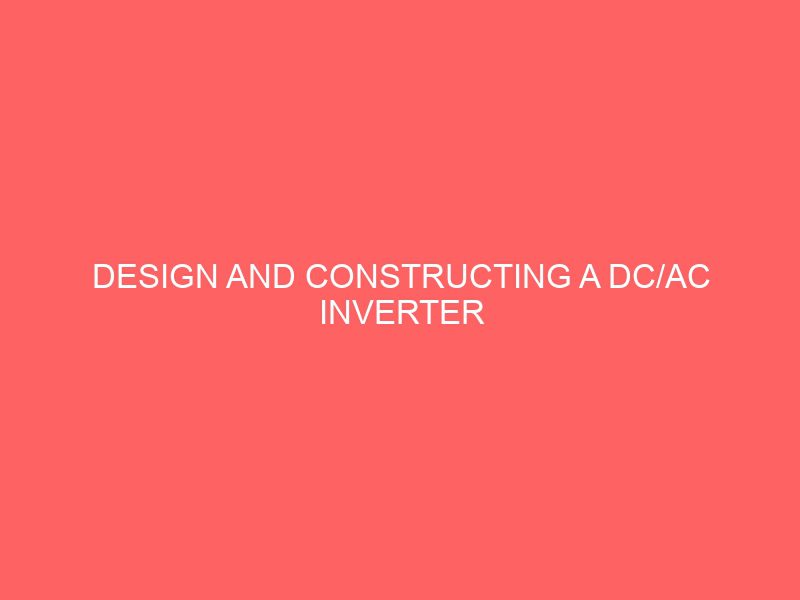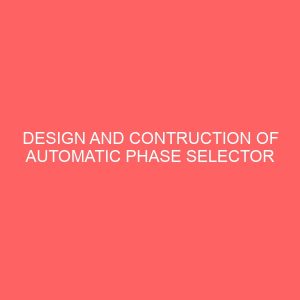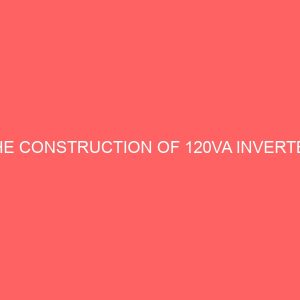Description
CHAPTER ONE
1.0 INTRODUCTION
The most recent advancement in technology has really given birth to different development in the field of engineering. Provision has been made by technologist who covers a wide range of humans environment, given solution to humans problems.
In the recent times, power supply has been epileptic in the country which has really affected consistent power source. Many power systems were found to be able to maintain power supply to the load during mains failure PHCN. Most of these loads were designed so that electrical supply to them should be maintained without interruption. Electricity can be generated by devices to convert some readily available sources of energy since electricity generation can be interrupted at any time as a result of fault and all electronic devices need an alternating current , the use of an inverter to utilize an alternative source of energy becomes so necessary.
An inverter is an electronic device which converts DC energy to AC energy. Thus, the technological breakthrough resulting to the production of this system has encouraged the optimum utilization of computers and related equipments. The beauty of inverter system is the fact that it accepts all the power anomalies, conditions and filters properly the public power supply output to most load which require pure grade sinusoidal voltage rated output. They are used in a wide variety of applications such as the complicated electronic systems of orbiting satellite and cool astronaut suites. Inverters are also used to operate gyroscope and other air borne instruments. Due to low voltage power sources such as solar cells, nuclear cells, and fuel cells, inverters has become increased in demand.
The system is unaffected by variation in the mains supply and during the period of power failure will continue to supply to the load for a specified duration. Modern DC to AC inverters is reliable and requires less maintenance
1.1 AIMS AND OBJECTIVES
The purpose of this project is aimed at designing and constructing a DC/AC inverter. It is necessitated by the quest to supply voltage to electrical electronic appliances in the advent of power failure from the mains PHCN.
1.2 JUSTIFICATON
In this design, the DC/AC inverter should be able to switch over to an alternating current AC at the advent of been powered by the mains and automatically charging the battery and reverse is the case when there is power failure from the mains.
1.3 LIMITATION
The DC/AC inverter can be produced or designed in different wattage as well as the output voltage models depending on the wattage and output voltage required by the users. It can be mounted or used in different areas of interest e.g. computer systems, ATM, household electronics either 120v or 240v output or many more.
1.4 METHOLOGY
A modular approach was adopted in which the design was incorporated namely, DC/AC converter unit. The a stable multi-vibrator low/high voltage transformation unit, charging unit, output unit.
These subunits would be designed, constructed and tested separately when all are confirmed to be working properly, there shall be appropriately connected. As much as practicable integrated circuit IC chips will be used to reduce components carried and enhance compatibility and reliability of the systems.
TABLE OF CONTENT
TITLE PAGE
CERTIFICATION i
DEDICATIONii
ACKNOWLEDGEMENTiii
ABSTRACTiv
TABLE OF CONTENTvixi
CHAPTER ONE
INTRODUCTION1
1.1 AIMS AND OBJECTIVES2
1.2 JUSTIFICATION2
1.3 LIMITATION23
1.4 METHODOLOGY3
1.5 SCOPE OF THE PROJECT3
1.6 BLOCK DIAGRAM4
1.7 DEFINITION OF OPERATIONAL TERMS45
CHAPTER TWO
2.0 LITERATURE REVIEW THEORY OF COMPONENTS6
2.1 DIODES67
2.1.1 TYPES OF SEMI CONDUCTOR DIODES7
2.1.2 NUMBERING AND CODING SCHEMES8
2.1.3 CONSTRUCTION OF A PN JUNCTION DIODE9
2.1.4 WORKING PRINCIPLE10
2.1.5 VOLTAGE CURRENT CHARACTERISTICS1011
2.1.6 DIODE PARAMETERS1112
2.1.7 APPLICATIONS OF DIODE12
2.2 RESISTORS13
2.2.1 TYPES OF RESISTORS13
2.2.2 COLOR CODING IN RESISTORS1417
2.2.3 LINEAR AND LOGARITHMIC TRAC1718
2.2.4 OHMS LAW1819
2.3 SWITCHES RELAY 1920
2.3.1 TYPES OF SWITCHES20
2.3.2 RELAYS2024
2.4 CAPACITORS25
2.4.1 DIELECTRICS25
2.4.2 CAPACITANCE25
2.4.3 TYPES OF CAPACITORS2628
2.4.4 INDICATING CAPACITANCE2830
2.5 TRANSFORMERS30
2.5.1 MUTUAL INDUCTANCE31
2.5.2 TRANSFORMER CONSTRUCTION32
2.5.3 TYPES OF TRANSFORMERS3133
2.5.4 E.M.F. EQUATION OF A TRANSFORMER3335
2.6 TRANSISTORS36
2.6.1 TRANSISTOR BIASING3638
2.6.2 TRANSISTOR AS A SWITCH3739
2.6.3 TRANSISTOR AS AN AMPLIFIER40
2.7 MULTIVIBRATORS40
2.7.1 ASTABLE MULTIVIBRATOR4143
2.7.2 CIRCUIT OPERATION4344
2.7.3 SWITCHING TIMES4445
2.8 POWER CELLS46
2.8.1 PRIMARY CELLS47
2.8.2 SECONDARY CELLS AND BATTERIES48
2.9 CONDUCTORS48
CHAPTER THREE
3.0 CONSTRUCTION OF DCAC INVERTER49
3.1 POWER CELL UNIT BATTERY49
3.2 DCAC CONVERTER UNIT4950
3.3 LOWHIGH VOLTAGE TRANSFORMATION UNIT5153
3.3.1 DETERMINATION OF THE WIRE DIAMETER53
3.4 THE BATTERY CHARGING UNIT54
3.4.1 FLOAT VOLTAGE55
3.4.2 EQUALISE VOLTAGE5556
3.4.3 TYPES OF CHARGE56
3.4.4 TRICKLE CHARGE5657
3.4.5 TYPICAL BATTERY CHARGER DESIGN57
3.5 PRINCIPLES OF OPERATION5760
CHAPTER FOUR
4.0 CONSTRUCTION TESTING AND RESULT61
4.1 CONSTRUCTION61
4.1.1 BREAD BOARD61
4.1.2 VERO BOARDING62
4.2 CONSTRUCTION OF CASING6263
4.3 TESTING6465
4.4 RESULT65
4.5 BILLS OF ENGINEERING MEASUREMENT AND
EVALUATION66
CHAPTER FIVE
5.0 CONCLUSION AND RECOMMENDATION67
5.1 CONCLUSION67
5.2 RECOMMENDATION67
5.3 REFERENCES6869








Reviews
There are no reviews yet.